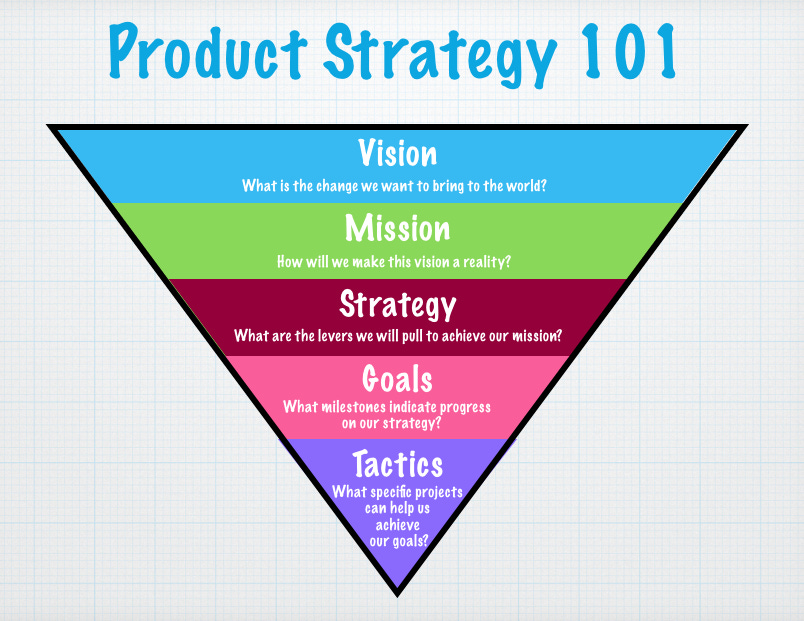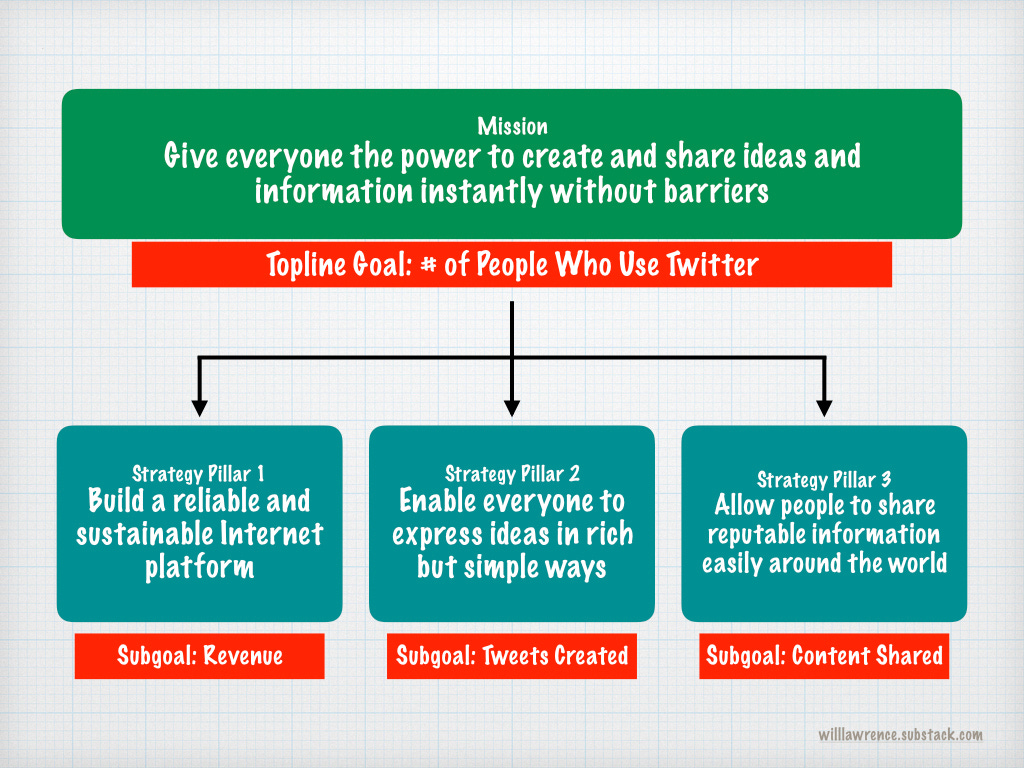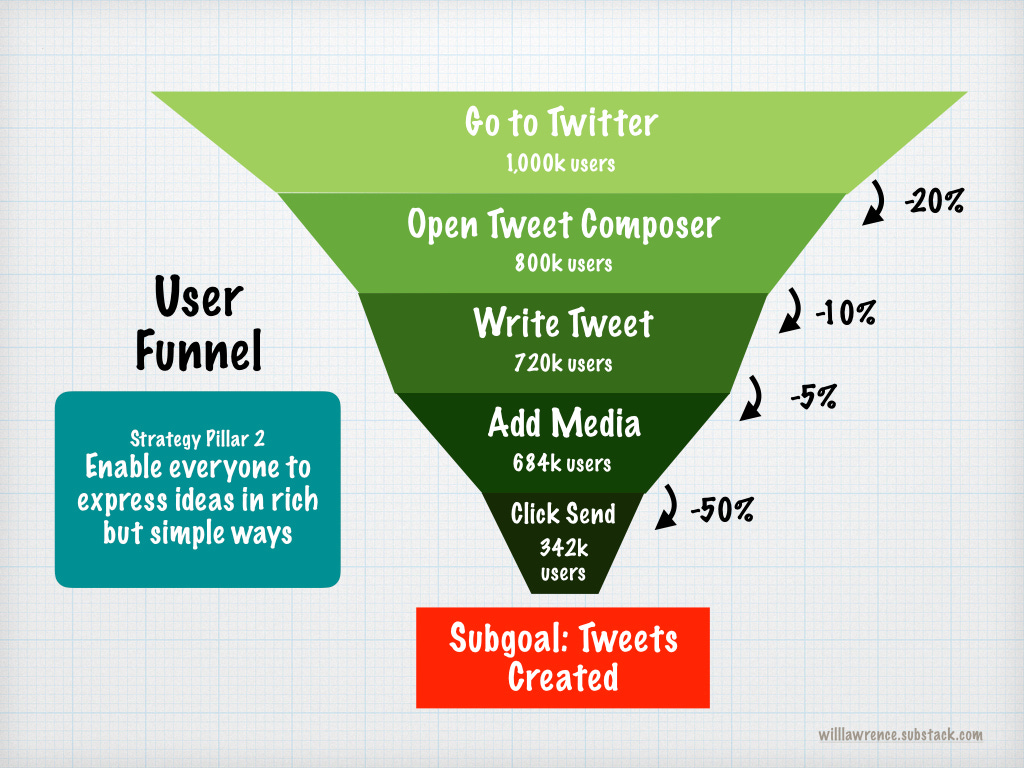How Product Managers Hit Goals
Use effective brainstorms and funnel analysis to find the best tactics to deploy
Five weeks ago, I said the backbone of product development was one, robust framework: a product strategy. Each week since then, we’ve discussed one part of this framework in detail. Here’s the tl;dr on each (with links if you want to dig in):
Vision - Your Northstar: The change you want in the world.
Mission- Your Route: The way you decide to bring your vision to reality.
Strategy - Your Transportation: The ways to move towards your mission.
Goals - Your GPS: The ways to measure progress on your strategy
Today, I want to share the final part of a product strategy:
Tactics - Your Gas Pedal: Actions that help you achieve your goals.
Ready, Set, Action!
Imagine you’re a new product manager for Twitter. Your VP has asked you to increase the number of people who tweet by 200%. That’s a big number - how do you do it?
You could start adding in features that you think solve the problem (ex. make the “Send Tweet” button 5x bigger 🤮). Or you can default to projects that sound great, like a major marketing campaign.
Here’s something that I’ve learned for situations like these: moving your goals stems from fixing user problems.
Here’s an approach that I use to find tactics that solve user problems:
Funnel analysis - visualize the user journey and identify frictions in it.
Reduce frictions - brainstorm tactics to improve the frictions you’ve identified.
Let’s give it a try!
Build the Funnel
Let’s return to Twitter’s strategy and goals that we identified last week:
Tactics are useful in advancing a single goal, so let’s work through Strategy Pillar #2 together. The goal of this strategy pillar is to increase the number of tweets created. How can we do that?
It’s always helpful to start with the user journey. A user’s journey to create a tweet likely involves the following steps:
Go to Twitter
Open the tweet composer
Write Tweet
Add media (photo, video, link etc.)
Click send
These steps are sequential. This means that the number of people on Step 1 (People who go to Twitter) will always be larger than the number on Step 2 (opening the tweet composer) which is always larger than the number of people on step 3 (writing the tweet) and so on. We can visualize this idea using a funnel:
The bottom of the funnel is our goal. This is because everyone who goes through the entire funnel sends a tweet and therefore contributes to our goal.
This funnel helps us visualize the purpose of tactics: advancing our strategy by getting more people to accomplish the goal (i.e. go through the entire funnel).
Funnel analysis is a framework for incremental improvements. This framework can be applied to many goals in life — waking up at 6 am, getting a 90% on an exam or even finding a romantic partner (top of the funnel could be # of swipes on Tinder 😆). Today, we’ll just apply it to Twitter to keep it simple.
The benefits of a funnel:
Identify frictions - once we know the steps of the funnel, we can pinpoint the spots that are causing friction for users.
Breaks down the problem - increasing the number of Tweets is a problem that’s too big to tackle by itself. But focussing on steps is much more palatable (ex. increasing the number of people who click "Send" from the tweet composer).
Focus on your goal - Narrowly focusing on your goal allows you to drive your strategy and mission.
Fill the Funnel
Next, we need to add in real data about the number of people at each step. This will help us identify the right tactics to achieve our goal.
If we plug in fictional data, our funnel for Twitter may look like this. (for simplicity, assume 1 user = 1 tweet).
Looking at the funnel, we can see that we lose the most people at the bottom of the funnel: 50% of users who add media don't click send.
This appears to be the main problem stopping us from furthering our goal.
Brainstorm Tactics
Our funnel analysis gives us an extremely clear problem: how can we get people who attach media to click send?
It’s time to brainstorm tactics to answer this question. In this context, a brainstorm identifies as many tactics as possible to solve the problem. Here are some principles for a successful brainstorm:
Bring in other people (from different backgrounds if possible)
All ideas are good! There are no bad ideas
Quantity > Quality
Build on other people’s ideas
Suspend all judgement
Here’s what I have:
You now have a list of potential tactics that may help you achieve your goal. Next step? Start trying them out!
Zooming Out
5 weeks ago, we started at a very high level by defining a vision. We've now come to the lowest level of strategy — tactics — where we have specific projects we can use to start advancing our strategy.
Whether you’re a PM or you just want to add some structure to your life, I hope these frameworks give you a way to realize what you care about and actionable ways to reach your goals. ☺️
If you’re new to Product Life, subscribe below for concise, actionable and often surprising lessons for product managers.
Until next time,






